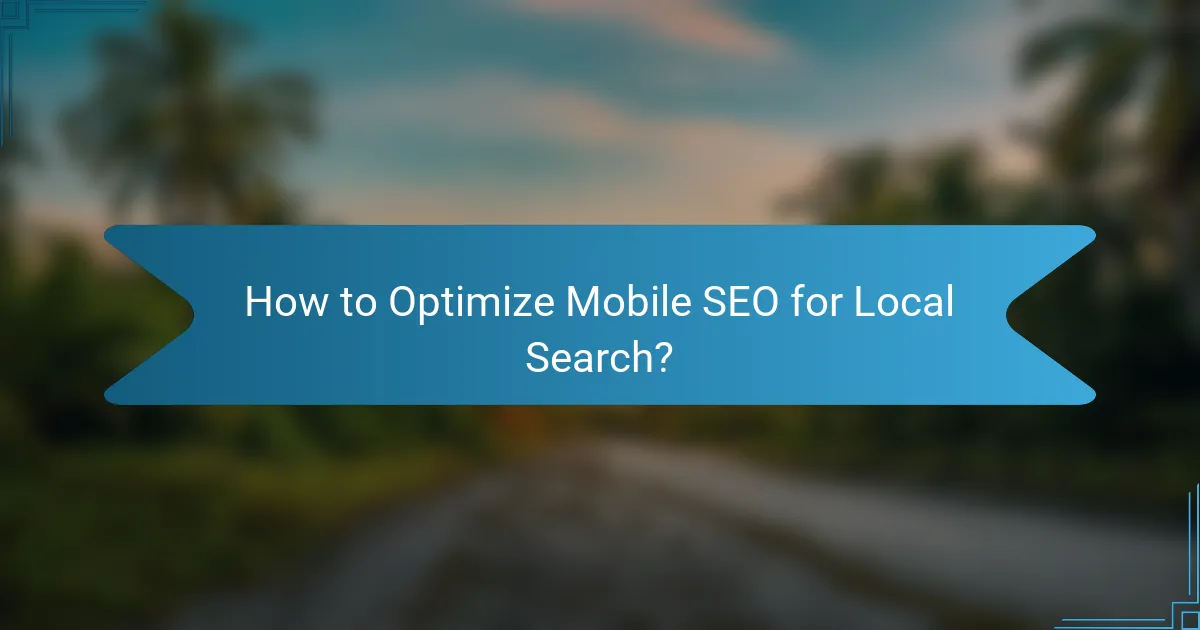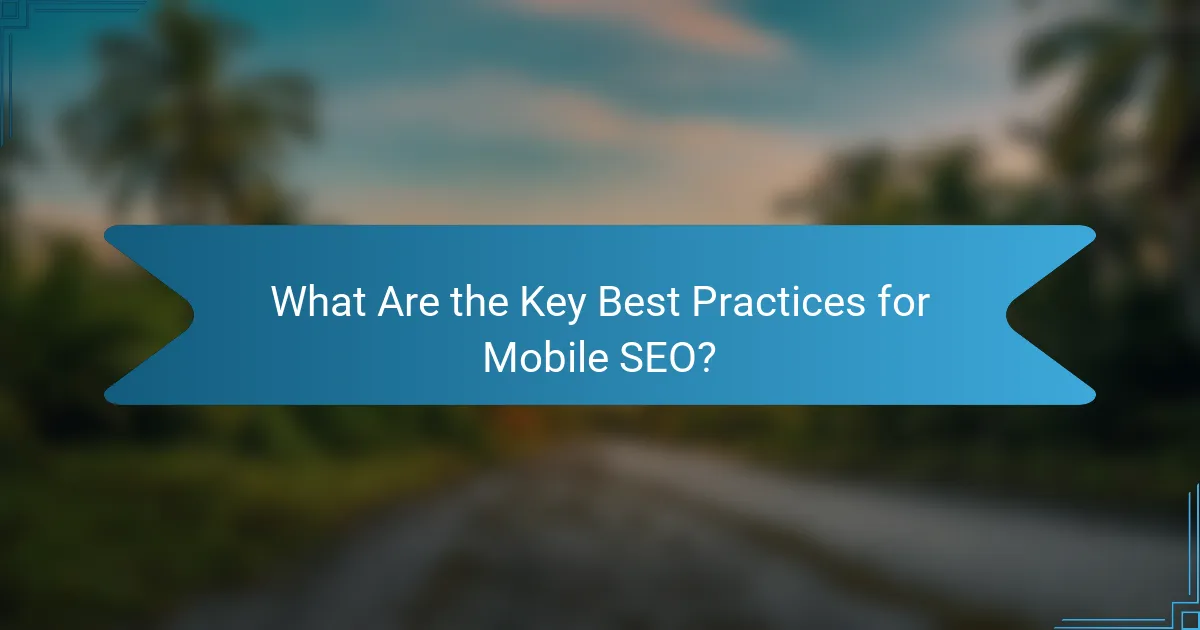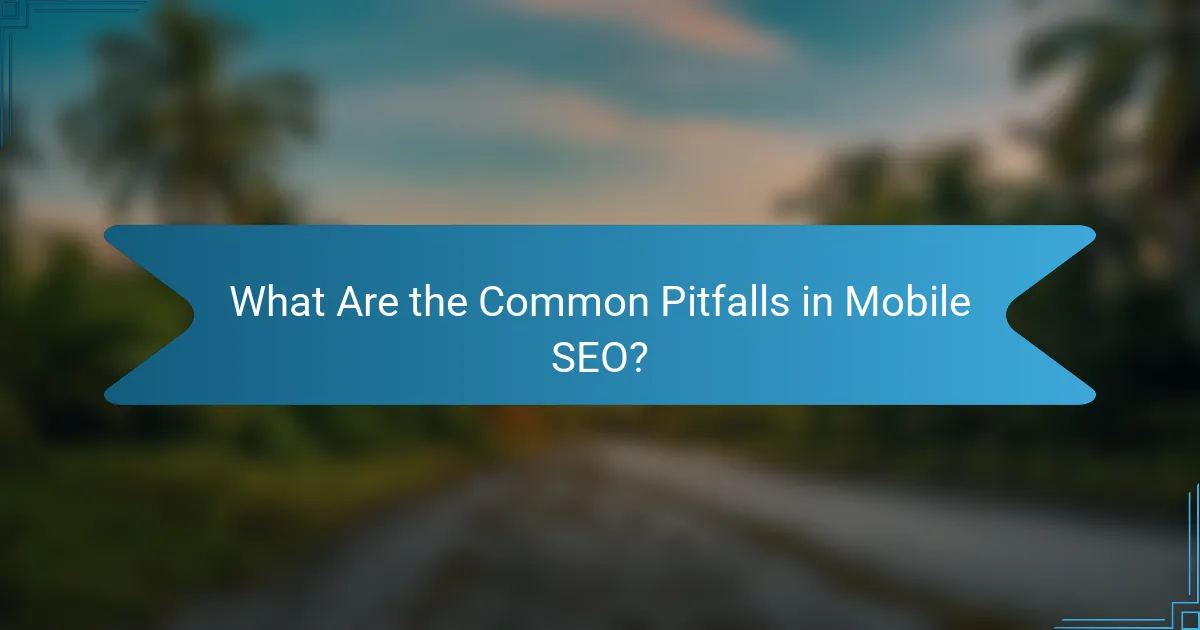Mobile SEO is essential for improving visibility in local search results and enhancing user experience on smartphones and tablets. By implementing best practices such as optimizing for mobile devices, managing your Google My Business profile, and using local keywords, you can significantly boost your site’s accessibility and performance. A focus on user experience not only keeps visitors engaged but also positively influences search rankings, making it crucial for any mobile strategy.

How to Optimize Mobile SEO for Local Search?
To optimize mobile SEO for local search, focus on enhancing visibility in local search results through targeted strategies. This includes using local keywords, managing your Google My Business profile, and ensuring your website is mobile-friendly.
Use Local Keywords
Incorporating local keywords is essential for improving your mobile SEO. Identify terms that potential customers in your area are searching for, such as “best coffee shop in [City]” or “plumber near me.” Use these keywords naturally in your website content, meta descriptions, and titles.
Consider using tools like Google Keyword Planner or local search tools to find relevant keywords. Aim for a mix of short-tail and long-tail keywords to capture a broader audience.
Implement Google My Business
Setting up and optimizing your Google My Business (GMB) listing is crucial for local search visibility. Ensure your business information is accurate, including your address, phone number, and operating hours. Regularly update your profile with new photos and posts to engage potential customers.
Encourage satisfied customers to leave positive reviews on your GMB listing, as this can significantly impact your local rankings. Responding to reviews, both positive and negative, also enhances your business’s credibility.
Optimize for Local Listings
Being listed in local directories can boost your mobile SEO. Ensure your business is included in relevant local listings such as Yelp, TripAdvisor, and local chambers of commerce. Consistency in your business name, address, and phone number (NAP) across these platforms is vital.
Regularly check these listings for accuracy and update them as needed. This not only helps with SEO but also improves customer trust and engagement.
Leverage Local Backlinks
Building backlinks from local websites can enhance your site’s authority and improve local search rankings. Reach out to local blogs, news sites, and community organizations to create partnerships or guest posts that link back to your website.
Participating in local events or sponsoring community activities can also lead to valuable backlinks. Aim for quality over quantity; a few high-quality local backlinks can be more effective than numerous low-quality ones.
Utilize Location-Based Content
Creating content that is specific to your local area can attract more local traffic. This could include blog posts about local events, guides to your city, or case studies featuring local customers. Such content not only engages your audience but also improves your relevance in local searches.
Consider using local landmarks or cultural references in your content to resonate more with your audience. This approach can help establish your business as a trusted local authority.

What Are the Key Best Practices for Mobile SEO?
Key best practices for mobile SEO focus on optimizing websites for mobile devices to enhance user experience and improve search rankings. Implementing these practices ensures that your site is accessible, fast, and user-friendly on smartphones and tablets.
Responsive Web Design
Responsive web design is essential for mobile SEO as it allows your website to adapt to various screen sizes and orientations. This approach uses flexible grids and layouts, ensuring that content is displayed correctly on any device. Google recommends responsive design as it simplifies indexing and improves user experience.
To implement responsive design, use CSS media queries to adjust styles based on device characteristics. Avoid separate mobile URLs, as they can lead to duplicate content issues and complicate SEO efforts.
Page Speed Optimization
Page speed optimization is critical for mobile SEO since slow-loading pages can lead to higher bounce rates and lower rankings. Aim for a loading time of under three seconds, as users expect quick access to content. Tools like Google PageSpeed Insights can help identify areas for improvement.
Common strategies for enhancing page speed include compressing images, minimizing JavaScript and CSS files, and leveraging browser caching. Prioritize mobile-specific optimizations, such as using AMP (Accelerated Mobile Pages) for faster loading on mobile devices.
Mobile-Friendly Navigation
Mobile-friendly navigation is vital for ensuring users can easily find information on your site. Simplify your menu structure and use larger touch targets to enhance usability on smaller screens. A well-organized navigation system improves user engagement and reduces frustration.
Consider implementing a hamburger menu or a sticky navigation bar to save screen space while providing easy access to important sections. Test your navigation on various devices to ensure it performs well across different platforms.
Optimize for Voice Search
Optimizing for voice search is increasingly important as more users rely on voice-activated devices. Focus on natural language and long-tail keywords that reflect how people speak rather than type. This approach can help capture traffic from voice search queries.
To enhance voice search optimization, create FAQ pages that address common questions in a conversational tone. Ensure your content is structured to provide direct answers, as voice search often seeks quick, concise responses.
Use Structured Data Markup
Structured data markup helps search engines understand your content better, improving visibility in search results. Implement schema markup to provide context about your pages, such as product details, reviews, and local business information. This can enhance your search listings with rich snippets.
Utilize Google’s Structured Data Markup Helper to create and test your markup. Regularly check for errors using the Rich Results Test tool to ensure your structured data is correctly implemented and recognized by search engines.

How Does User Experience Impact Mobile SEO?
User experience significantly impacts mobile SEO by influencing how users interact with a website on their devices. A positive experience can lead to longer visit durations and lower bounce rates, both of which are favorable for search rankings.
Importance of Mobile Usability
Mobile usability refers to how easily users can navigate and interact with a website on their mobile devices. Key factors include responsive design, intuitive navigation, and accessible content. Websites that prioritize usability tend to retain visitors and encourage engagement, which can improve search engine rankings.
To enhance mobile usability, ensure that buttons are appropriately sized, text is legible without zooming, and the layout adapts seamlessly to different screen sizes. Regular usability testing can help identify and rectify potential issues.
Effects of Page Load Speed
Page load speed is critical for mobile SEO, as slow-loading pages can frustrate users and lead to higher bounce rates. Research shows that a delay of just a few seconds can significantly decrease user satisfaction and engagement. Aim for a load time of under three seconds to keep visitors on your site.
To improve load speed, optimize images, minimize code, and leverage browser caching. Tools like Google PageSpeed Insights can provide actionable recommendations for enhancing performance.
Role of Mobile-Friendly Content
Mobile-friendly content is designed to be easily consumed on smaller screens, which is essential for maintaining user engagement. This includes using concise text, bullet points, and multimedia elements that enhance understanding without overwhelming users.
Consider breaking up long paragraphs and using headings to guide readers through the content. Additionally, ensure that any interactive elements, such as forms or buttons, are easy to use on touchscreens. Regularly reviewing and updating content can help keep it relevant and engaging for mobile users.

What Tools Can Help with Mobile SEO?
Several tools can significantly enhance your mobile SEO efforts by providing insights into performance, usability, and optimization strategies. Utilizing these tools can help ensure your website is mobile-friendly and ranks well in search results.
Google Search Console
Google Search Console is a vital tool for monitoring your website’s performance in search results. It provides data on how your site appears on mobile devices, including mobile usability issues that may affect rankings.
To get started, verify your site with Google Search Console and check the “Mobile Usability” report. This report highlights any issues that could hinder mobile user experience, such as clickable elements being too close together or content wider than the screen.
Mobile-Friendly Test Tool
The Mobile-Friendly Test Tool by Google allows you to evaluate how easily a visitor can use your page on a mobile device. Simply enter your URL, and the tool will analyze the page for mobile compatibility.
This tool provides a straightforward pass/fail result, along with suggestions for improvements. Common issues include text that is too small to read and the need for responsive design adjustments.
PageSpeed Insights
PageSpeed Insights measures the performance of your web pages on both mobile and desktop devices. It offers insights into loading speed and provides actionable recommendations to enhance performance.
Focus on the scores provided for both mobile and desktop versions. Aim for a score above 90 for optimal performance. Key areas to improve often include image optimization, reducing server response times, and minimizing JavaScript blocking.

What Are the Common Pitfalls in Mobile SEO?
Common pitfalls in mobile SEO include neglecting local optimization, failing to ensure fast loading times, and not optimizing for mobile user experience. Addressing these issues is crucial for improving visibility and engagement on mobile devices.
Neglecting Local Optimization
Neglecting local optimization can severely limit a business’s visibility in mobile search results. Mobile users often search for services and products nearby, making local SEO essential for attracting foot traffic and local customers.
To effectively optimize for local search, ensure your business is listed on Google My Business and other relevant local directories. Include accurate information such as your address, phone number, and operating hours. Additionally, encourage customer reviews to enhance your local credibility.
Utilize local keywords in your content and meta tags to improve relevance. For example, if you run a bakery in Sofia, use phrases like “best bakery in Sofia” to target local searches. Regularly update your content to reflect local events or promotions, keeping it fresh and engaging for users.
